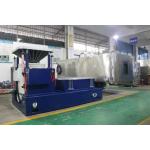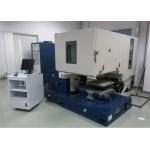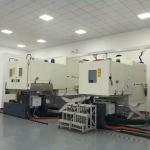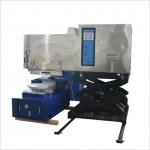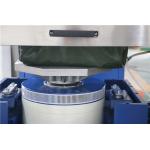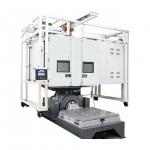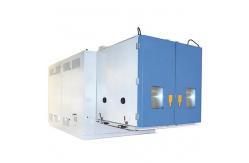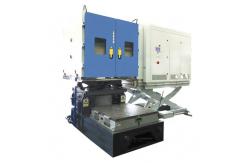In the world of packaging and product testing, ensuring the
integrity and durability of goods during transit and storage is of
utmost importance. The customized vibration tester with
environmental test chambers, designed to meet ISTA (International
Safe Transit Association) standards, offers a comprehensive
solution for evaluating the performance of products under a variety
of simulated real-world conditions. This advanced testing equipment is specifically engineered to
subject products to a combination of vibration and environmental
stresses in accordance with ISTA's rigorous testing protocols. It
serves industries such as e-commerce, manufacturing, logistics, and
consumer goods. The primary objective is to assess how well
products and their packaging can withstand the vibrations and
environmental factors they are likely to encounter during shipping,
handling, and warehousing. By conducting tests that comply with
ISTA standards, companies can optimize their packaging designs,
enhance product protection, and minimize the risk of damage and
returns. - Robust and Modular Chamber Construction
- The environmental test chambers are built with a heavy-duty steel
frame that provides exceptional rigidity and stability. The frame
is coated with a corrosion-resistant finish to ensure long-term
durability. The chambers are designed in a modular fashion,
allowing for easy customization and integration of different
components. The interior of the chambers is made of high-quality
insulation materials, which minimize heat transfer and maintain
precise temperature and humidity levels. The insulation is
carefully selected to withstand the rigors of continuous testing
and prevent any external factors from interfering with the internal
test environment. The chambers are also equipped with a hermetic
door seal, ensuring a leak-free enclosure and consistent test
conditions.
- Precision Vibration System
- The vibration tester incorporated into the chambers is a marvel of
engineering. It can generate a wide range of vibration frequencies
and amplitudes. The frequency range can span from 2 Hz to 2000 Hz,
allowing for the simulation of various real-world vibration
sources, such as those from trucks, trains, airplanes, and conveyor
belts. The vibration amplitude can be adjusted from a few
micrometers to several centimeters, depending on the test
requirements. The vibration table is made of a high-strength alloy
and is dynamically balanced to ensure uniform and stable vibration
transmission. It is controlled by a sophisticated computerized
control unit that allows for the creation of complex vibration
profiles, including random vibrations, sine waves, and shock
pulses.
- Accurate Temperature and Humidity Control
- The chambers feature a highly accurate temperature and humidity
control system. They can maintain a wide temperature range, from
-40°C to +150°C, with an accuracy of ±0.5°C. The humidity control
range extends from 10% to 98% relative humidity, with an accuracy
of ±2% RH. The system utilizes advanced refrigeration units,
electric heaters, humidifiers, and dehumidifiers to achieve and
maintain the desired environmental conditions. Temperature and
humidity sensors are strategically placed within the chambers to
provide real-time feedback, enabling the control system to make
rapid and precise adjustments.
- Customizable Interior and Fixtures
- The chambers offer a customizable interior space to accommodate
different sizes and shapes of test samples. They can be equipped
with adjustable shelves, racks, and mounting fixtures, allowing for
flexible test setups. The interior surfaces are made of
non-corrosive and non-reactive materials to prevent any
contamination or interaction with the test samples. Additionally,
the chambers can be fitted with various accessories, such as cable
ports, viewing windows, and access doors, to facilitate testing and
monitoring.
- Intuitive Control and Data Acquisition Interface
- The equipment is equipped with an intuitive control panel and a
sophisticated data acquisition system. The control panel allows
operators to easily set and adjust the vibration, temperature,
humidity parameters, and test durations according to ISTA
standards. It provides real-time display of the current test
conditions and any alarms or warnings. The data acquisition system
records all relevant test data, including temperature and humidity
profiles, vibration waveforms, and any changes in the physical
properties of the test samples. The data can be stored in a
built-in memory or exported to external storage devices for further
analysis. The system also has the ability to generate detailed test
reports in various formats, such as PDF or Excel.
- Compliance with ISTA Standards
- The tester and chambers are specifically calibrated and programmed
to perform tests in strict accordance with ISTA standards. It can
replicate the various vibration profiles, temperature and humidity
cycles, and test durations specified in the relevant ISTA test
procedures. This ensures that the test results are valid and
comparable, allowing manufacturers and shippers to make informed
decisions about packaging design, material selection, and quality
control. The equipment also provides a means for documenting
compliance with ISTA standards, which is essential for
demonstrating due diligence and meeting customer and regulatory
requirements.
- Vibration Frequency Range
- As mentioned, the vibration frequency range of 2 Hz to 2000 Hz
covers a wide spectrum of vibrations that products may experience
during transit. Low-frequency vibrations can affect the stability
and alignment of larger and heavier products, while high-frequency
vibrations can cause fatigue and failure in smaller, more delicate
components. Testing across this frequency range ensures a
comprehensive evaluation of a product's performance under different
vibration scenarios.
- Vibration Amplitude Range
- The vibration amplitude can be adjusted from a few micrometers to
several centimeters. This flexibility allows for the simulation of
both mild and severe vibration conditions. For example, a small
electronic device may require a relatively small vibration
amplitude to test its resistance to the vibrations of a delivery
van, while a large industrial machine part may need to be tested at
a higher amplitude to simulate the rough handling it might receive
during shipping.
- Temperature Cycling Range
- The chambers can perform temperature cycling within the range of
-40°C to +150°C. This wide temperature range is crucial for testing
products that may be shipped or stored in extreme climates. For
instance, products destined for arctic regions may need to
withstand extremely low temperatures, while those in tropical or
desert areas may face high temperatures. Temperature cycling also
helps to evaluate the thermal expansion and contraction
characteristics of products and their packaging.
- Humidity Cycling Range
|
